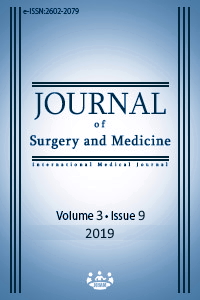Investigation of fungal flora in hammams, Turkish baths: A field study
Keywords:
Hammam, Turkish bath, Fungi, DermatophytesAbstract
Aim: Hammams, also known as Turkish Hammams or Turkish Baths, have preserved their traditional importance and popularity in various countries, namely, Turkey, Morocco, Yemen, and Algeria. In this study, we aimed to evaluate the fungal flora in hammams and its effects on public health.
Methods: This cross-sectional study was performed by collecting two hundred forty samples from different areas of the baths and the tools used. Collected samples were inoculated on Sabouraund dextrose agar and Potato dextrose agar for mycological evaluation. Agar plates were incubated at 25 °C and 37 °C for four weeks and fungal growth was observed every day. For identification of isolated fungi, micro and macro morphology was evaluated; germ tube test, biochemical tests and VITEK®2 Compact (Biomerieux, France) equipment were used.
Results: We determined that molds are the most common fungi in Turkish hammams. Aspergillus spp. (n=20), Scedosporium apiospermum/boydii (n=5), Alternaria ulocladium (n=1), Rhizomucor spp. (n=1) and Penicillium spp. (n=1) were isolated in collected samples. Isolated yeasts were Trichosporon spp. (n=6), Candida albicans (n=1) and Candida tropicalis (n=1). Trichophyton tonsurans, the dermatophyte, was isolated in two samples. Fungus was most commonly isolated from slippers, and not at all isolated from towels or peshtemals.
Conclusion: In our study, the most isolated molds were fungi, found in the nature, and the isolation rate was exceptionally low. Dermatophytes are the most common culprit of fungal transmission in public places such as baths. Compared to previous studies conducted in swimming pools, wrestling cushions, mosque carpets and slippers, our study showed that Turkish baths with high humidity and temperatures are not rich in fungal flora and that the risk of fungal contamination is low.
Downloads
References
Benammar L, Menasria T, Chergui A, Benfiala S, Ayachi, A. Indoor fungal contamination of traditional public baths (Hammams). International Biodeterioration&Biodegradation. 2017;117:115-22.
Dahdah MJ, Scher RK. Dermatophytes. Curr Fungal Infect Rep. 2008;2:81.
Hilmarsdottir I, Haraldsson H, Sigurdardottir A, Sigurgeirsson B. Dermatophytes in a Swimming Pool Facility: Difference in Dermatophyte Load in Men’s and Women’s
Dressing Rooms. Acta Derm Venereol. 2005;1:1-1.
Goksugur N, Karabay O, Kocoglu E. Mycological flora of the Hammams, traditional Turkish bath. Journal Compilation. 2006;49:411–14.
Yenisehirli G, Karat E, Bulut Y, Savci U. Dermatophytes Isolated from the Mosques in Tokat, Turkey. Mycopathologia. 2012;174:327–30.
Kavanagh K. Fungi: Biology and Applications. 2nd ed. 2011, Wiley-Blackwell.
Svejgaard EL. Epidemiology of dermatophytes in Europe. Int J Dermatol. 1995;34:525-28.
Hannuksela ML, Ellahham S. Benefits and risks of sauna bathing. Am J Med. 2001;110:118-26.
Murray PR, Rosenthal KS, Pfaller MC. Medical Microbiology. Başustaoğlu AC et al. (Translated), 6.th ed, 2010. Atlas Press. Ankara
Chen TC, Ho MW, Chien WC, Lin HH. Disseminated Scedosporium apiospermum infection in a near-drowning patient. J Formos Med Assoc. 2016;115:213-4.
Luplertlop N, Muangkaew W, Pumeesat P, Suwanmanee S, Singkum P. Distribution of Scedosporium species in soil from areas with high human population density and tourist popularity in six geographic regions in Thailand. PloS one. 2019;14:e0210942.
Hannuksela M, Vaananen A. The sauna, skin and skin diseases. Ann Clin Res. 1988;20:276-8.
Hamada N, Abe N. Physiological characteristics of 13 common fungal species in bathrooms. Mycoscience. 2009;50:421-9.
Ilkit M. Onychomycosis in Adana, Turkey: a 5-year study. Int J Dermatol. 2005;44:851-4.
Demir F, Kustimur S. Investigation of Some Virulence Factors in Trichosporon spp. Strains. Mikrobiyol Bul. 2017;48:628-38.
Bhattacharyya S, Gupta P, Banerjee G, Jain A, Singh M. In-vitro inhibition of biofilm formation in Candida albicans and Candida tropicalis by heat stable compounds in culture filtrate of Aspergillus flavus. J. Clin. Diagn Res. 2013;7:2167-88.
Pitt JI, Hocking AD. Fungi and Food Spoilage. Springer Press. 2009, New York
Hiruma J, Ogawa Y, Hiruma M. Trichophyton tonsurans infection in Japan: Epidemiology, clinical features, diagnosis and infection control Authors. J Dermatol. 2015;42:245-9.
Downloads
- 1196 2144
Published
Issue
Section
How to Cite
License
Copyright (c) 2019 Ünsal Savcı, Mustafa Şahin
This work is licensed under a Creative Commons Attribution-NonCommercial-NoDerivatives 4.0 International License.
















